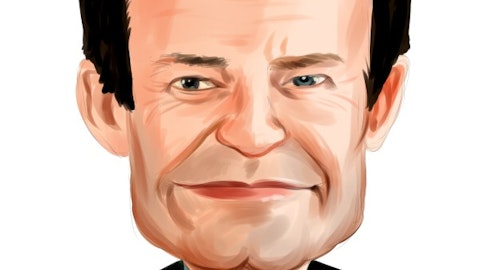Lisa Su: Sure, Mark. So we – so the first – the second question, yes. We do believe the first quarter is the bottom for our PC market – for our PC business, and we’ll see some growth in the second quarter and then a seasonally higher second half. In terms of the under shipment, I mean, I think we’re – we undershipped in Q3, we undershipped in Q4. We will undership, to a lesser extent, in Q1. So I think you can infer that from our guidance single-digit down. And then we’ll be back to a more normal environment. Now just as a reminder though, the first half is not usually a – the first half is usually a seasonally weak client time anyways. So, we would expect more lift in the second half, not so much in the second quarter.
Mark Lipacis: Got you, okay. That’s very helpful, thank you. And then a follow-up, if I may, on the – China is lifting, as they’re lifting the COVID restrictions, I guess I would imagine that you would expect that ultimately, at some point, to translate into higher demand. And I’m wondering if you could just kind of share with us your thoughts about how that might play out? And could you remind us is, to the extent that you can help us understand of the risk to the supply side for you in the event that the COVID spreads rapidly as they lift the restrictions and impacts what you have on the supply side there? Thank you.
Lisa Su: Sure, Mark. So we’ve done a very good job in our supply chain in terms of risk mitigation. So we have – we don’t believe that we have a significant risk as it relates to COVID future outbreaks, if there are any. As it relates to China recovery, I think we would benefit from a China recovery. It’s very difficult to call. I mean we’ve seen, certainly in our Data Center business, we saw in the second half of the year and last year in the first half of this year that the China Data Center business has been weak for us. If there was a recovery, I think we would benefit from that. Similarly, some of the other consumer patterns as well. But it’s very difficult to call. So we put that in the bucket of macro uncertainty, and we’ll see how it plays out.
Ruth Cotter: Operator, we’ll take two more questions from two callers, please?
Operator: Certainly. Our next question is coming from Chris Danley from Citi. Your line is now live.
Chris Danley: Great, thanks ladies. Congrats on being the first all-female CEO, CFO team – that’s means long time coming. So your gross margins held up pretty well for the Q1 guide despite high-margin Data Center business going down. So if the Data Center business remains weak and has a rough quarter in Q2, can we expect a similar gross margin resiliency?
Jean Hu: Yes, definitely. I think as I said earlier, the major impact on gross margin actually is the PC client side. The stabilization and the bottoming of client business really help us with the gross margin at the current level. Second half, we should see the expansion of gross margin.
Chris Danley: Sure and as my follow-up on your PC client business. So it – had its correction a little bit later than some of the other folks in the semi industry and was obviously a little bit steeper. Can you talk about why that happened and why we should – should or should not expect that or could that happen in the Data Center business as well?
Lisa Su: I guess, Chris, what I would say is I think the PC market has been volatile, and we did significantly – coming off the pandemic, there was very high demand during the pandemic, and I think we were all adjusting as we’re looking at sort of the demand environment post pandemic and with macro uncertainty. I think the Data Center business we have you know again, we’re heavily weighted towards cloud. And we have very good discussions with our overall customer set in terms of what they need. I think what’s going in our favor in the Data Center is our workloads are expanding. And so, we’ve heard from all of our cloud customers that they’re adopting both Milan and Genoa in more workloads than previous. And so I think that gives us good confidence.
And frankly, the Data Center customers are also giving us good visibility into what they need for 2023. So there is an adjustment in the first half. And I think that’s something that we understand. And we also expect that we’re going to have to ramp up production in the second half as some of the demand resumes. And I think, the overall factor of compute in the cloud being a very important long-term driver is definitely there. So, we feel good about sort of where we’re positioned.
Operator: Thank you. Our final question today is coming from Timothy Arcuri from UBS. Your line is now live.
Timothy Arcuri: Hi, thanks a lot. Lisa, I had a question on your client business. I know that your competitor at times uses rebates and subsidies. But the numbers that are in their filings have gotten pretty vague. So I take it from your answer to a prior question that you think that’s more on legacy parts? I guess I’m just kind of wondering what changes or impact that’s had on your business? And I continue to hear these worries that it’s going to have some lasting effect on your share and particularly on your margins? Thanks.





